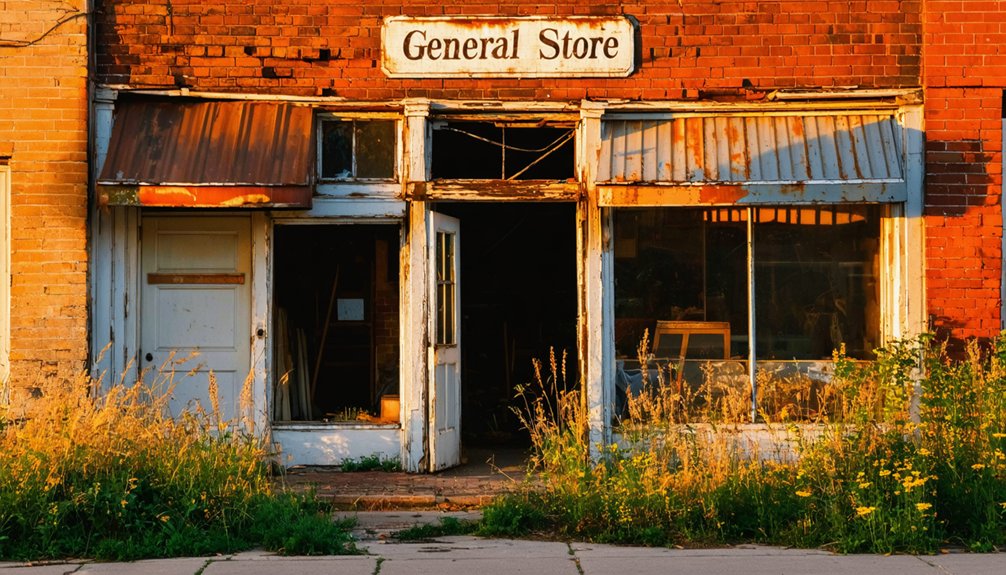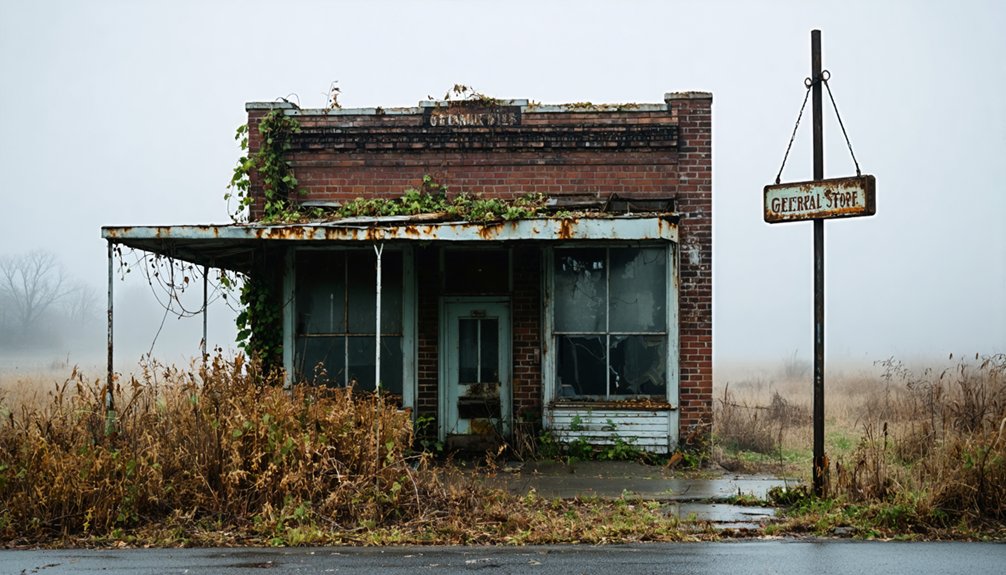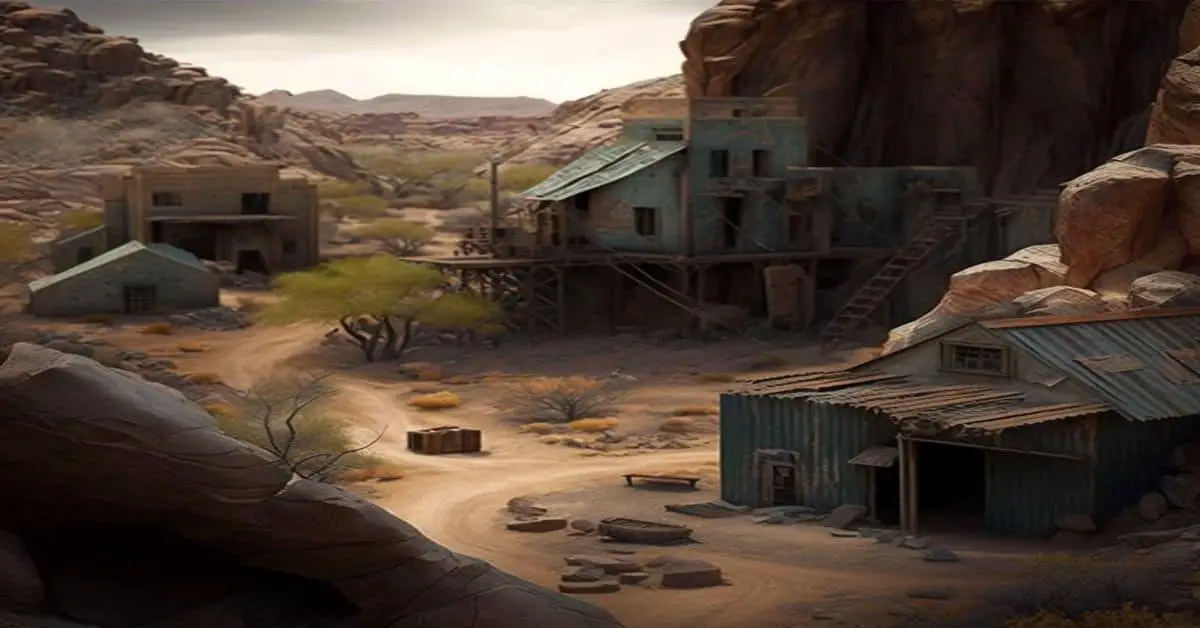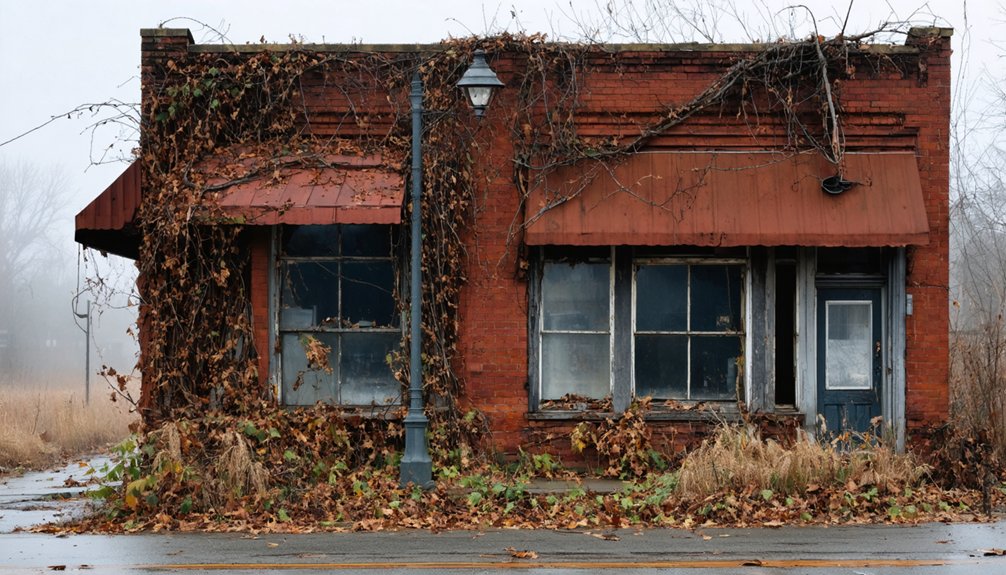You’ll find Glen Hall’s ghostly remains in Tippecanoe County, Indiana, where this once-promising agricultural settlement has faded into one of the state’s most obscure ghost towns. The community thrived briefly in the early 19th century around farming and local trade, but economic isolation and devastating floods gradually drove residents away. Today, only two houses stand as silent witnesses to Glen Hall’s existence, while its untold stories and mysteries await those who venture to explore its past.
Key Takeaways
- Glen Hall was an agricultural settlement in Tippecanoe County, Indiana that declined due to economic isolation and poor infrastructure development.
- Only two houses remain in Glen Hall today, making it one of Indiana’s most diminished ghost towns with minimal physical remnants.
- The town’s abandonment stemmed from being bypassed by major transportation routes and losing residents to larger, better-connected neighboring communities.
- Recurring floods and soil erosion undermined building foundations and agricultural viability, contributing to the town’s eventual abandonment.
- Unlike other Indiana ghost towns, Glen Hall lacks documented legends, preserved architecture, or organized preservation efforts to maintain its history.
The Rise and Fall of Glen Hall
While many small Indiana communities flourished briefly during the 19th century, Glen Hall emerged as a modest agricultural hub in Tippecanoe County before ultimately succumbing to the fate of countless rural towns.
You’ll find that community dynamics centered around farming cycles, with local businesses and a post office serving nearby agricultural operations. The town’s strategic position along transportation routes initially promised growth and prosperity. Like the town of Anita’s railroad line, Glen Hall depended heavily on rail transportation for its economic survival. Similar to other locations requiring proper disambiguation, historical records sometimes confuse Glen Hall with other similarly named places.
However, Glen Hall’s story mirrors that of many Indiana ghost towns. As Lafayette grew and rail networks shifted, the town’s importance diminished.
Like countless rural communities before it, Glen Hall faded into obscurity as nearby Lafayette expanded and transportation routes changed.
Economic forces dealt the final blow during the mid-20th century, when changing agricultural practices and industrial development drew younger residents away.
Today, Glen Hall exists only in historical records, a reflection of the dramatic shifts that reshaped rural America.
Life in Early Glen Hall Settlement
As Native American settlements gave way to European pioneers in early 19th-century Indiana, Glen Hall emerged from the rich cultural tapestry of Tippecanoe County. You would’ve found a community shaped by the convergence of Native American heritage and European settlement patterns, with families establishing homesteads near essential waterways that facilitated trade and transportation.
Early agriculture defined daily life, as settlers adapted indigenous farming techniques while introducing their own methods. The community benefited from generations of Mississippian maize cultivation that had proven successful in the region. You’d have witnessed cultural exchanges between remaining Native American tribes and newcomers, creating a unique blend of traditions and practices.
The settlement’s economy thrived on a combination of farming, hunting, and gathering – much like the Native Americans before them. Families worked together to cultivate the land, trading surplus goods through networks that connected Glen Hall to broader regional markets.
Economic Challenges That Shaped Glen Hall
Despite its promising beginnings, Glen Hall faced severe economic challenges that ultimately contributed to its downfall. The town’s economic isolation became increasingly apparent as limited access to markets and poor transportation infrastructure created significant investment barriers.
You’d have seen the impact of this isolation in the decline of traditional farming and manufacturing sectors, while larger neighboring towns drew away both businesses and residents. New transportation route changes caused businesses and residents to relocate to better-connected areas. Similar to Gary’s decline in the 1970s, the town suffered from foreign competition that devastated local industries.
The town’s struggles intensified as it failed to diversify its economy or adapt to modern technologies. You would’ve witnessed how national economic shifts and global market pressures hit Glen Hall particularly hard, while its aging population and growing skills gap made economic recovery even more challenging.
The lack of substantial revitalization efforts, combined with these persistent challenges, sealed the town’s economic fate.
Natural Forces and Environmental Impact
Through its history, Glen Hall battled significant environmental challenges that would ultimately contribute to its abandonment.
Similar to how clean drinking water determined where many small towns were established, you’ll find the town’s location near water sources exposed it to devastating flood impacts, while soil erosion gradually undermined building foundations and agricultural viability. Climate fluctuations and seasonal weather patterns created an unstable environment that discouraged rebuilding efforts after repeated natural damage.
- Recurring floods deposited sediment that permanently altered the local landscape and water management capabilities.
- Natural vegetation changes following abandonment led to ecosystem instability and further environmental degradation.
- The region’s glacial soil deposits and freeze-thaw cycles accelerated structural decay.
- Nature’s reclamation process transformed the ghost town through ecological succession, rewilding formerly settled areas.
Community Spirit and Social Fabric
The vibrant social fabric of Glen Hall once pulsed with the rhythms of daily life, creating bonds that held the community together even in challenging times.
You would’ve found yourself immersed in regular community gatherings that strengthened relationships among neighbors, from church socials to town meetings at the local community center.
The neighborhood dynamics reflected the close-knit nature of small-town life, where everyone knew each other and pitched in during times of need.
Small towns thrive on familiarity and mutual aid, where neighbors are more than just faces—they’re extended family ready to help.
Local leaders emerged naturally, guiding the town’s development while maintaining its cultural identity through festivals and traditional practices.
Much like modern genealogical records that preserve family connections, the town kept detailed accounts of its residents and their relationships.
When conflicts arose, the community’s problem-solving approach helped preserve harmony.
This spirit of mutual support and social cohesion defined Glen Hall’s character until its eventual decline, much like the Indiana ghost town of Story, which also maintained strong community ties until its abandonment.
Notable Buildings and Landmarks
Remnants of Glen Hall‘s built environment have largely faded into Indiana’s landscape, leaving few documented landmarks from this once-thriving community.
Unlike nearby ghost towns that feature preserved mills, churches, or commercial buildings of historical significance, Glen Hall’s architectural remnants remain largely undocumented in state preservation records.
The town never developed grand structures like the theater-style sanctuaries that characterize other historic Indiana communities.
Indiana’s rapid post-Civil War industrialization transformed many towns, but Glen Hall missed this wave of development.
- No standing churches or chapels have been officially registered as historic landmarks, though religious buildings once served as essential community hubs.
- Transport infrastructure, including any rail depots or stage stops, has disappeared from the landscape.
- Commercial structures that typically anchored similar ghost towns aren’t preserved in Glen Hall’s footprint.
Nearby communities like Hindostan and Fort Ritner offer better examples of preserved 19th-century architecture, with restored mills and general stores still standing.
Comparing Glen Hall to Other Indiana Ghost Towns

When you compare Glen Hall to other Indiana ghost towns, you’ll find its quiet fade into obscurity stands in stark contrast to dramatic abandonments like Hindostan’s plague-driven exodus or Millville’s economic collapse from changing transportation patterns.
While local legends and detailed histories surround many Indiana ghost towns, Glen Hall’s story remains largely undocumented, with few surviving tales or records of its brief existence.
Unlike Hindostan’s preserved ruins or Millville’s restored canal features, Glen Hall has left minimal physical traces on the landscape, making it one of Indiana’s more mysterious lost settlements.
Common Abandonment Patterns
Comparing Glen Hall’s abandonment to other Indiana ghost towns reveals distinct patterns that shaped the fate of 19th-century settlements across the state.
While Glen Hall’s specific abandonment triggers aren’t well documented, you’ll find that population decline in similar towns typically followed predictable paths.
- Economic shifts hit hard when railroads and highways bypassed communities, redirecting commerce to better-connected locations.
- Loss of county seat status proved fatal for towns like Hindostan, though Glen Hall never held this position.
- Public health crises, particularly cholera and smallpox outbreaks, caused rapid abandonment in some settlements.
- Environmental challenges and single-industry dependence made towns vulnerable, though Glen Hall’s exact economic base remains unclear.
These patterns suggest that most ghost towns didn’t simply fade away – they were victims of specific historical forces that reshaped Indiana’s landscape.
Local Legends Compared
Most Indiana ghost towns boast rich folklore traditions and supernatural tales, yet Glen Hall stands apart for its notable absence of documented legends.
While other abandoned towns feature vivid accounts of ghostly encounters – like Henry Dixon’s lantern haunting the Southern Indiana railway tunnel or Diana of the Dunes patrolling Mt. Tom – Glen Hall remains mysteriously silent in local folklore collections.
You’ll find that neighboring ghost towns often weave their supernatural stories around tragic events, historic figures, or abandoned infrastructure.
These places host annual festivals celebrating their spectral residents and draw curious visitors to reportedly haunted cemeteries and former town sites.
Glen Hall’s limited historical footprint, however, has left it without the rich tapestry of paranormal narratives that typically define Indiana’s ghost towns.
Preservation Status Today
Unlike its better-preserved counterparts across Indiana, Glen Hall stands as one of the state’s most severely diminished ghost towns, with just two houses remaining where a once-thriving community existed.
You’ll find its historic significance dramatically reduced compared to places like Elkinsville or Elizabethtown, where preservation strategies have helped maintain various structures and community connections.
- Tunnelton’s 1857 train tunnel remains a major attraction while Glen Hall’s railroad infrastructure has vanished completely
- Other ghost towns feature maintained barns, post offices, and occasional community reunions
- Local preservation efforts in towns like Old English help protect gardens and historic structures
- Glen Hall lacks the physical remnants and organized preservation efforts seen in the 13+ documented ghost towns across southern Indiana
Preserving Glen Hall’s Legacy

The preservation of Glen Hall’s legacy encompasses five key areas: historical documentation, community engagement, physical conservation, digital archiving, and sustainable funding.
Through extensive archival research, you’ll find that local historical societies and preservation groups work diligently to document Glen Hall’s past through photographs, maps, and oral histories.
Community involvement plays a vital role, as residents and descendants contribute family stories and artifacts that help piece together the town’s historical narrative.
Local residents breathe life into Glen Hall’s history by sharing cherished family stories and donating meaningful artifacts from their personal collections.
You’ll see evidence of this collaborative effort in the archaeological surveys and field schools that confirm the site’s historical features.
Indiana’s Division of Historic Preservation and Archaeology supports these initiatives by providing systematic monitoring and data preservation, ensuring that Glen Hall’s heritage remains accessible for future generations to study and appreciate.
Exploring Glen Hall Today
When visiting Glen Hall today, you’ll encounter little more than whispers of its former existence, as this extinct Indiana town has largely returned to nature.
For those interested in urban exploration and historical documentation, you’ll need careful preparation to locate and study this forgotten settlement’s remains.
- Bring GPS equipment and detailed maps, as there’s limited signage or marked access to the site
- Research local property boundaries and obtain necessary permissions before exploring
- Document any foundations, plot layouts, or artifacts you discover for historical records
- Plan your visit during daylight hours to safely navigate overgrown terrain
While Glen Hall’s physical traces may be scarce, your exploration can contribute valuable insights to understanding Indiana’s network of ghost towns and their role in the state’s development.
Frequently Asked Questions
Were Any Films or Documentaries Ever Made About Glen Hall?
You won’t find any film adaptations or documentary features about this place, surprisingly – despite Indiana’s rich paranormal documentary history, no filmmaker has captured Glen Hall’s story for the screen.
What Native American Tribes Originally Inhabited the Glen Hall Area?
You’ll find the Miami, Potawatomi, and Delaware were the primary Native tribes in your area, with Kickapoo, Shawnee, Wea, and Piankashaw people also traveling through these historically significant lands.
Did Glen Hall Have Its Own Newspaper During Its Existence?
Like many frontier outposts lacking printing presses, you wouldn’t have found a dedicated newspaper in Glen Hall. Local journalism and newspaper history records suggest residents relied on publications from neighboring communities.
What Was the Peak Population of Glen Hall Before Decline?
You won’t find exact population records, but based on historical significance and population trends of similar Indiana ghost towns, Glen Hall’s peak population likely didn’t exceed 200 residents during its existence.
Were There Any Famous Outlaws or Crimes Associated With Glen Hall?
Like a blank page in history’s ledger, you won’t find any outlaw legends or crime stories linked to Glen Hall. Historical records don’t reveal any documented criminal activity in this forgotten place.
References
- https://www.youtube.com/watch?v=45D4dbASJyE
- http://freepages.rootsweb.com/~gtusa/history/usa/in.htm
- https://ancestors.familysearch.org/en/9D9Y-DWF/glenn-hall-1890-1948
- https://en.wikipedia.org/wiki/Glen_Hall
- https://en.everybodywiki.com/Altamont_Switch
- https://en.wikipedia.org/wiki/List_of_ghost_towns_in_Indiana
- https://www.wikiwand.com/en/articles/List_of_ghost_towns_in_Indiana
- https://kids.kiddle.co/List_of_ghost_towns_in_Indiana
- https://www.onlyinyourstate.com/experiences/indiana/ghost-towns-in
- https://blog.newspapers.com/the-haunted-house-from-jackson-county-indiana/



